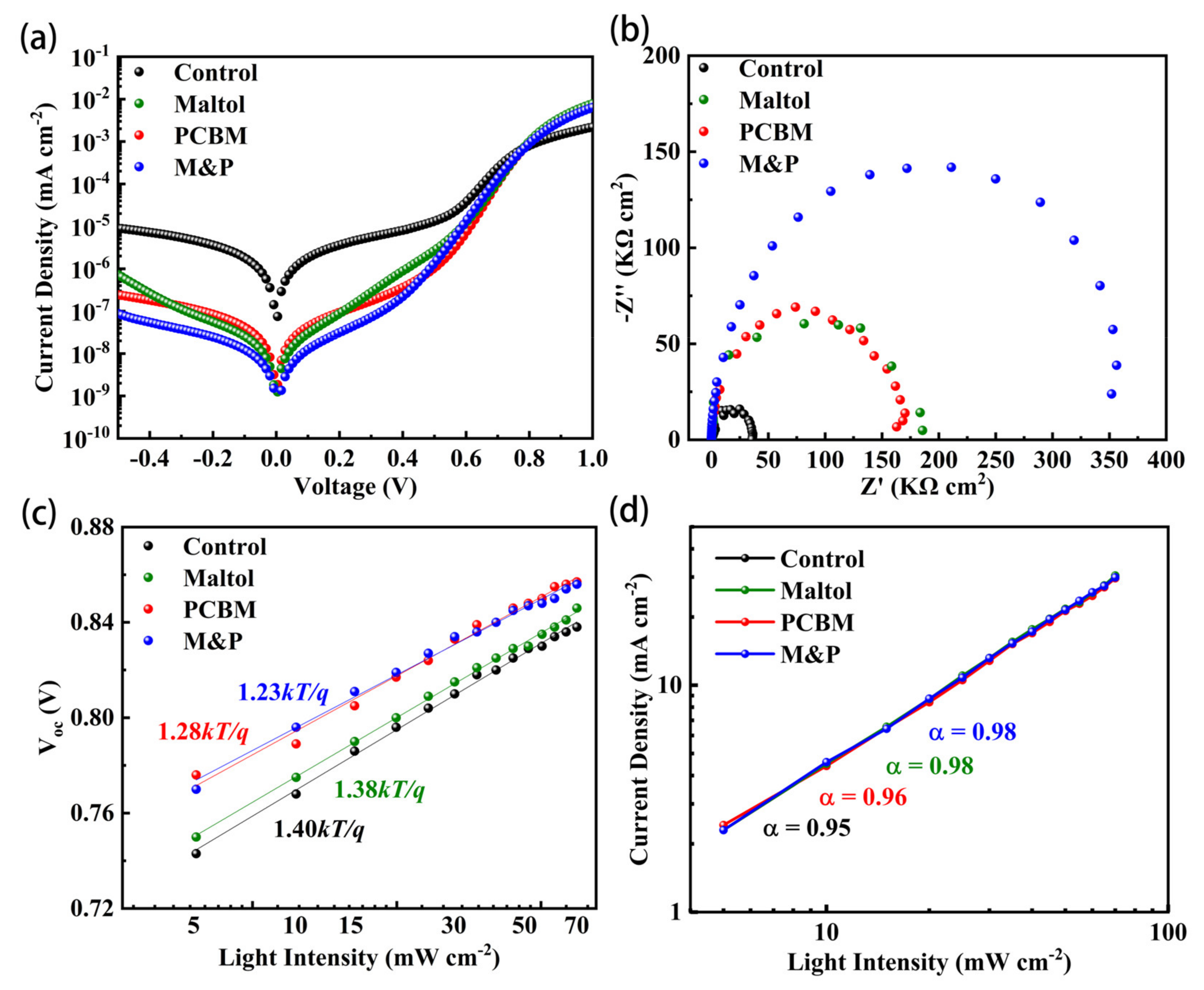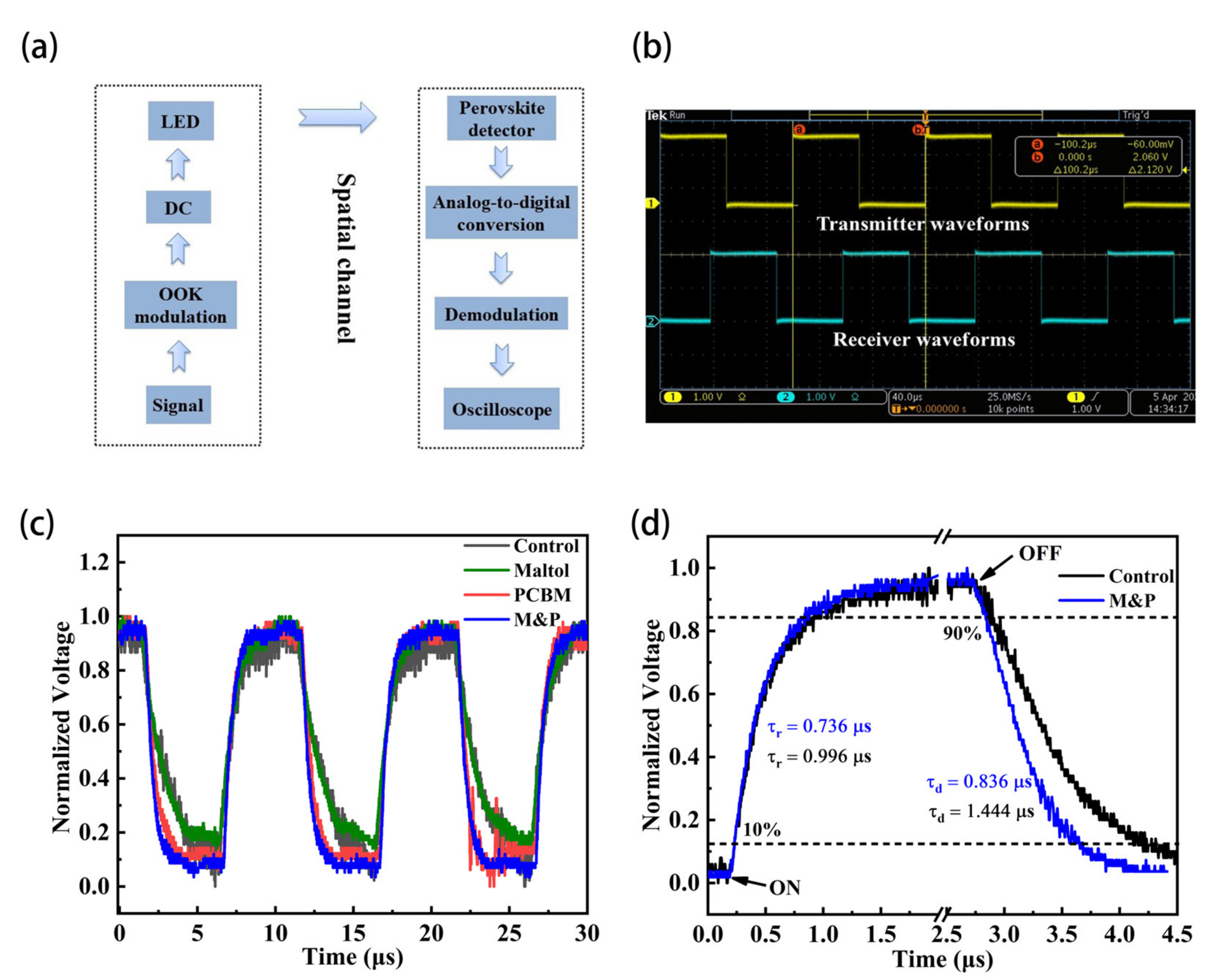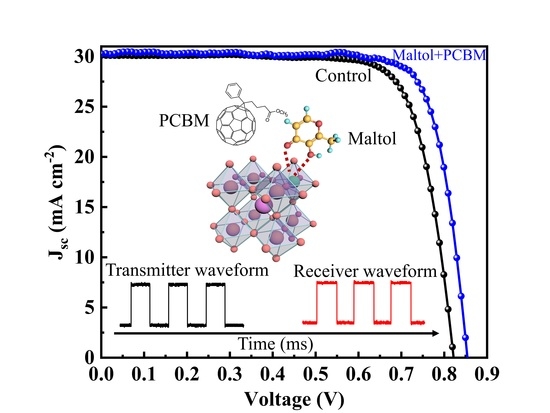Back Interface Passivation for Efficient Low-Bandgap Perovskite Solar Cells and Photodetectors
Abstract
:1. Introduction
2. Materials and Methods
2.1. Materials
2.2. Perovskite Precursor Solution
2.3. Maltol and PCBM Solutions
2.4. Device Fabrication
2.5. Material Characterizations and Device Performance Measurements
3. Results and Discussion
4. Conclusions
Supplementary Materials
Author Contributions
Funding
Data Availability Statement
Acknowledgments
Conflicts of Interest
References
- Zhao, J.J.; Deng, Y.H.; Wei, H.T.; Zheng, X.P.; Yu, Z.H.; Shao, Y.C.; Shield, J.E.; Huang, J.S. Strained hybrid perovskite thin films and their impact on the intrinsic stability of perovskite solar cells. Sci. Adv. 2017, 3, 5616. [Google Scholar] [CrossRef] [PubMed] [Green Version]
- Wang, H.; Wang, X.M.; Zhang, H.F.; Ma, W.G.; Wang, L.Z.; Zong, X. Organic-inorganic hybrid perovskites: Game-changing candidates for solar fuel production. Nano Energy 2020, 71, 104647. [Google Scholar] [CrossRef]
- Wang, X.; Ling, Y.; Chiu, Y.C.; Du, Y.; Barreda, J.L.; Perez-Orive, F.; Ma, B.; Xiong, P.; Gao, H. Dynamic electronic junctions in organic-inorganic hybrid perovskites. Nano Lett. 2017, 17, 4831–4839. [Google Scholar] [CrossRef]
- Zhang, Y.P.; Wang, Y.S.; Xu, Z.Q.; Liu, J.Y.; Song, J.C.; Xue, Y.Z.; Wang, Z.Y.; Zheng, J.L.; Jiang, L.C.; Zheng, C.X.; et al. Reversible structural swell-shrink and recoverable optical Properties in Hybrid Inorganic-Organic peroe. ACS Nano 2016, 10, 7031–7038. [Google Scholar] [CrossRef]
- Gu, C.W.; Lee, J.S. Flexible hybrid organic-inorganic perovskite memory. ACS Nano 2016, 10, 5413–5418. [Google Scholar] [CrossRef] [PubMed]
- Liao, W.; Zhao, D.; Yu, Y.; Shrestha, N.; Ghimire, K.; Grice, C.R.; Wang, C.; Xiao, Y.; Cimaroli, A.J.; Ellingson, R.J.; et al. Fabrication of efficient low-bandgap perovskite solar cells by combining formamidinium tin iodide with methylammonium lead iodide. J. Am. Chem. Soc. 2016, 138, 12360–12363. [Google Scholar] [CrossRef] [PubMed]
- Wang, C.; Song, Z.; Li, C.; Zhao, D.; Yan, Y. Low-bandgap mixed tin-lead perovskites and their applications in all-perovskite tandem solar cells. Adv. Funct. Mater. 2019, 29, 1808801. [Google Scholar] [CrossRef]
- Hu, S.; Otsuka, K.; Murdey, R.; Nakamura, T.; Truong, M.A.; Yamada, T.; Handa, T.; Matsuda, K.; Nakano, K.; Nakano, A.; et al. Optimized carrier extraction at interfaces for 23.6% efficient tin–lead perovskite solar cells. Energy Environ. Sci. 2022, 15, 2096–2107. [Google Scholar] [CrossRef]
- Luo, P.; Liu, Z.; Xia, W.; Yuan, C.; Cheng, J.; Lu, Y. A simple in situ tubular chemical vapor deposition processing of large-scale efficient perovskite solar cells and the research on their novel roll-over phenomenon in J–V curves. J. Mater. Chem. A 2015, 3, 12443–12451. [Google Scholar] [CrossRef]
- Ono, L.K.; Leyden, M.R.; Wang, S.; Qi, Y. Organometal halide perovskite thin films and solar cells by vapor deposition. J. Mater. Chem. A 2016, 4, 6693–6713. [Google Scholar] [CrossRef] [Green Version]
- Lei, Y.; Gu, L.; He, W.; Jia, Z.; Yang, X.; Jia, H.; Zheng, Z. Intrinsic charge carrier dynamics and devices stability of perovskite/ZnO mesostructured solar cells in moisture. J. Mater. Chem. A 2016, 4, 5474–5481. [Google Scholar] [CrossRef]
- Stranks, S.D.; Snaith, H.J. Metal-halide perovskites for photovoltaic and light-emitting devices. Nat. Nanotechnol. 2015, 10, 391–402. [Google Scholar] [CrossRef]
- Tan, Z.K.; Moghaddam, R.S.; Lai, M.L.; Docampo, P.; Higler, R.; Deschler, F.; Price, M.; Sadhanala, A.; Pazos, L.M.; Credgington, D.; et al. Bright light-emitting diodes based on organometal halide perovskite. Nat. Nanotechnol. 2014, 9, 687–692. [Google Scholar] [CrossRef]
- Bao, C.; Yang, J.; Bai, S.; Xu, W.; Yan, Z.; Xu, Q.; Liu, J.; Zhang, W.; Feng, G. High performance and stable all-inorganic metal halide perovskite-based photodetectors for optical communication applications. Adv. Mater. 2018, 30, 1803422. [Google Scholar] [CrossRef] [Green Version]
- Lin, R.; Xiao, K.; Qin, Z.; Han, Q.; Zhang, C.; Wei, M.; Saidaminov, M.I.; Gao, Y.; Xu, J.; Xiao, M.; et al. Monolithic all-perovskite tandem solar cells with 24.8% efficiency exploiting comproportionation to suppress Sn (Ⅱ) oxidation in precursor ink. Nat. Energy 2019, 4, 864–873. [Google Scholar] [CrossRef]
- Shao, S.; Liu, J.; Portale, G.; Fang, H.H.; Blake, G.R.; Brink, G.H.; Koster, J.A.; Loi, M.A. Highly reproducible Sn-based hybrid perovskite solar cells with 9% efficiency. Adv. Energy Mater. 2018, 8, 1702019. [Google Scholar] [CrossRef]
- Gupta, S.; Cahen, D.; Hodes, G. How SnF2 impacts the material properties of lead-free tin perovskites. J. Phys. Chem. C 2018, 122, 13926–13936. [Google Scholar] [CrossRef]
- Lee, S.J.; Shin, S.S.; Kim, Y.G.; Kim, G.; Ahn, T.K.; Noh, J.H.; Seo, J.; Seok, S. Fabrication of efficient formamidinium tin iodide perovskite solar cells through SnF2–pyrazine complex. J. Am. Chem. Soc. 2016, 138, 3974–3977. [Google Scholar] [CrossRef]
- Lin, R.; Xu, J.; Wei, M.; Wang, Y.; Qin, Z.; Liu, Z.; Wu, J.; Xiao, K.; Chen, B.; Park, S.M.; et al. All-perovskite tandem solar cells with improved grain surface passivation. Nature 2022, 603, 73–78. [Google Scholar] [CrossRef]
- Hu, S.; Truong, M.A.; Otsuka, K.; Handa, T.; Yamada, T.; Nishikubo, R.; Iwasaki, Y.; Saeki, A.; Murdey, R.; Kanemitsu, Y.; et al. Mixed lead–tin perovskite films with >7 μs charge carrier lifetimes realized by maltol post-treatment. Chem. Sci. 2021, 12, 13513–13519. [Google Scholar] [CrossRef]
- Wang, S.; Sakurai, T.; Wen, W.; Qi, Y. Energy level alignment at interfaces in metal halide perovskite solar cells. Adv. Mater. Interfaces 2018, 5, 1800260. [Google Scholar] [CrossRef]
- Bin, Z.; Li, J.; Wang, L.; Duan, L. Efficient n-type dopants with extremely low doping ratios for high performance inverted perovskite solar cells. Energy Environ. Sci. 2016, 9, 3424–3428. [Google Scholar] [CrossRef]
- Pan, M.A.; Lau, T.K.; Tang, Y.; Wu, Y.C.; Liu, T.; Li, K.; Chen, M.C.; Lu, X.; Ma, W.; Zhan, C. 16.7%-efficiency ternary blended organic photovoltaic cells with PCBM as the acceptor additive to increase the open-circuit voltage and phase purity. J. Mater. Chem. A 2019, 7, 20713–20722. [Google Scholar] [CrossRef]
- Dou, L.; Yang, Y.M.; You, J.; Hong, Z.; Chang, W.H.; Li, G.; Yang, Y. Solution-processed hybrid perovskite photodetectors with high detectivity. Nat. Commun. 2014, 5, 5404. [Google Scholar] [CrossRef]
- Song, T.B.; Yokoyama, T.; Stoumpos, C.C.; Logsdon, J.; Cao, D.H.; Wasielewski, M.R.; Aramaki, S.; Kanatzidis, M.G. Importance of reducing vapor atmosphere in the fabrication of tin-based perovskite solar cells. J. Am. Chem. Soc. 2017, 139, 836–842. [Google Scholar] [CrossRef]
- Kapil, G.; Ripolles, T.S.; Hamada, K.; Ogomi, Y.; Bessho, T.; Kinoshita, T.; Chantana, J.; Yoshino, K.; Shen, Q.; Toyoda, T.; et al. Highly efficient 17.6% tin–lead mixed perovskite solar cells realized through spike structure. Nano Lett. 2018, 18, 3600–3607. [Google Scholar] [CrossRef]
- Chen, C.; Song, Z.; Xiao, C.; Zhao, D.; Shrestha, N.; Li, C.; Yang, G.; Yao, F.; Zheng, X.; Ellingson, R.J.; et al. Achieving a high open-circuit voltage in inverted wide-bandgap perovskite solar cells with a graded perovskite homojunction. Nano Energy 2019, 61, 141–147. [Google Scholar] [CrossRef]
- Du, Y.; Wu, J.; Zhang, X.; Zhu, Q.; Zhang, M.; Liu, X.; Zou, Y.; Wang, S.; Sun, W. Surface passivation using pyridinium iodide for highly efficient planar perovskite solar cells. J. Energy Chem. 2021, 52, 84–91. [Google Scholar] [CrossRef]
- Brinkmann, K.O.; Becker, T.; Zimmermann, F.; Kreusel, C.; Gahlmann, T.; Haeger, T.; Riedl, T. The optical origin of near-unity external quantum efficiencies in perovskite solar cells. Sol. RRL 2021, 5, 2100371. [Google Scholar] [CrossRef]
- Li, C.; Song, Z.; Zhao, D.; Xiao, C.; Subedi, B.; Shrestha, N.; Junda, M.M.; Wang, C.L.; Jiang, C.S.; Al-Jassim, M.; et al. Reducing saturation-current density to realize high-efficiency low-bandgap mixed tin–lead halide perovskite solar cells. Adv. Energy Mater. 2019, 9, 1803135. [Google Scholar] [CrossRef]
- Liu, Y.; Chen, Q.; Duan, H.S.; Zhou, H.; Yang, Y.M.; Chen, H.; Luo, S.; Song, T.B.; Dou, L.; Hong, Z.; et al. Dopant-free organic hole transport material for efficient planar heterojunction perovskite solar cells. J. Mater. Chem. A 2015, 3, 11940–11947. [Google Scholar] [CrossRef]
- Mandoc, M.M.; Kooistra, F.B.; Hummelen, J.C.; Boer, B.; Blom, P.W.M. Effect of traps on the performance of bulk heterojunction organic solar cells. Appl. Phys. Lett. 2007, 91, 263505. [Google Scholar] [CrossRef] [Green Version]
- Koppens, F.H.L.; Mueller, T.; Avouris, P.; Ferrari, A.C.; Vitiello, M.S.; Polini, M. Photodetectors based on graphene, other two-dimensional materials and hybrid systems. Nat. Nanotechnol. 2014, 9, 780–793. [Google Scholar] [CrossRef] [PubMed]
- Chen, H.; Liu, H.; Zhang, Z.; Hu, K.; Fang, X. Nanostructured photodetectors: From ultraviolet to terahertz. Adv. Mater. 2016, 28, 403–433. [Google Scholar] [CrossRef] [PubMed]
- Khan, L.U. Visible light communication: Applications, architecture, standardization and research challenges. Digit. Commun. Netw. 2017, 3, 78–88. [Google Scholar] [CrossRef] [Green Version]
- Zvanovec, S.; Chvojka, P.; Haigh, P.A.; Ghassmlooy, Z. Visible light communications towards 5G. Radioengineering 2015, 24, 1–9. [Google Scholar] [CrossRef]
- Singh, D.; Basu, C.; Wollweber, M.M.; Roth, B. LEDs for energy efficient greenhouse lighting. Renew. Sust. Energ. Rev. 2015, 49, 139–147. [Google Scholar] [CrossRef] [Green Version]
- Zhang, X.; Liu, C.; Ren, G.; Li, S.; Bi, C.; Hao, Q.; Liu, H. High-switching-ratio photodetectors based on perovskite CH3NH3PbI3 nanowires. Nanomaterials 2018, 8, 318. [Google Scholar] [CrossRef] [Green Version]
- Mapunda, G.A.; Ramogomana, R.; Marata, L.; Basutli, B.; Khan, A.S.; Chuma, J.M. Indoor visible light communication: A tutorial and survey. Wirel. Commun. Mob. Comput. 2020, 2020, 8881305. [Google Scholar] [CrossRef]
- Wu, Y.; Yang, A.; Feng, L.; Zuo, L.; Sun, Y. Modulation based cells distribution for visible light communication. Opt. Express 2012, 20, 24196–24208. [Google Scholar] [CrossRef]
- Ali, H.; Zhang, Y.; Tang, J.; Peng, K.; Sun, S.; Sun, Y.; Song, F.; Falak, A.; Wu, S.; Qian, C.; et al. High-responsivity photodetection by a self-catalyzed phase-pure p-GaAs nanowire. Small 2018, 14, 1704429. [Google Scholar] [CrossRef]
- Fang, Y.; Huang, J. Resolving weak light of sub-picowatt per square centimeter by hybrid perovskite photodetectors enabled by noise reduction. Adv. Mater. 2015, 27, 2804–2810. [Google Scholar] [CrossRef]
- Hao, D.; Liu, D.; Shen, Y.; Shi, Q.; Huang, J. Air-stable self-powered photodetectors based on lead-free CsBi3I10/SnO2 heterojunction for weak light detection. Adv. Funct. Mater. 2021, 31, 2100773. [Google Scholar] [CrossRef]
- Pang, T.; Jia, R.; Wang, Y.; Sun, K.; Hu, Z.; Zhu, Y.; Luan, S.; Zhang, Y. Self-powered behavior based on the light-induced self-poling effect in perovskite-based transport layer-free photodetectors. J. Mater. Chem. C 2019, 7, 609–616. [Google Scholar] [CrossRef]
- Wang, J.; Xiao, S.; Qian, W.; Zhang, K.; Yu, J.; Xu, X.; Wang, G.; Zheng, S.; Yang, S. Self-driven perovskite narrowband photodetectors with tunable spectral responses. Adv. Mater. 2021, 33, 2005557. [Google Scholar] [CrossRef]
- Wu, C.Y.; Peng, W.; Fang, T.; Wang, B.; Xie, C.; Wang, L.; Yang, W.H.; Luo, L.B. Asymmetric contact-induced self-driven perovskite-microwire-array photodetectors. Adv. Electron. Mater. 2019, 5, 1900135. [Google Scholar] [CrossRef]
- Shaikh, P.A.; Shi, D.; Retamal, J.R.D.; Sheikh, A.D.; Haque, M.A.; Kang, C.F.; He, J.H.; Bakr, O.M.; Wu, T. Schottky junctions on perovskite single crystals: Light-modulated dielectric constant and self-biased photodetection. Adv. Electron. Mater. 2016, 4, 8304–8312. [Google Scholar] [CrossRef]
- Tong, G.; Geng, X.; Yu, Y.; Yu, L.; Xu, J.; Jiang, Y.; Sheng, Y.; Shi, Y.; Chen, K. Rapid, stable and self-powered perovskite detectors via a fast chemical vapor deposition process. RSC Adv. 2017, 7, 18224–18230. [Google Scholar] [CrossRef] [Green Version]
- Tang, F.; Chen, Q.; Chen, L.; Ye, F.; Cai, J.; Chen, L. Mixture interlayer for high performance organic-inorganic perovskite photodetectors. Appl. Phys. Lett. 2016, 109, 123301. [Google Scholar] [CrossRef]
- Sutherland, B.R.; Johnston, A.K.; Ip, A.H.; Xu, J.; Adinolfi, V.; Kanjanaboos, P.; Sargent, E. Sensitive, fast, and stable perovskite photodetectors exploiting interface engineering. ACS Photonics 2015, 2, 1117–1123. [Google Scholar] [CrossRef]
- Bao, C.; Zhu, W.; Yang, J.; Li, F.; Gu, S.; Wang, Y.; Yu, T.; Zhu, J.; Zhou, Y.; Zou, Z. Highly flexible self-powered organolead trihalide perovskite photodetectors with gold nanowire networks as transparent electrodes. ACS Appl. Mater. Interfaces 2016, 8, 23868–23875. [Google Scholar] [CrossRef]





| Voc (V) | Jsc (mA cm−2) | FF (%) | PCE (%) | |
|---|---|---|---|---|
| Control | 0.821 | 30.08 | 76.8 | 18.96 |
| Maltol | 0.829 | 30.48 | 79.1 | 19.98 |
| PCBM | 0.858 | 29.80 | 78.1 | 20.00 |
| M&P | 0.854 | 30.28 | 79.7 | 20.62 |
Publisher’s Note: MDPI stays neutral with regard to jurisdictional claims in published maps and institutional affiliations. |
© 2022 by the authors. Licensee MDPI, Basel, Switzerland. This article is an open access article distributed under the terms and conditions of the Creative Commons Attribution (CC BY) license (https://creativecommons.org/licenses/by/4.0/).
Share and Cite
Lu, J.; Wang, H.; Fan, T.; Ma, D.; Wang, C.; Wu, S.; Li, X. Back Interface Passivation for Efficient Low-Bandgap Perovskite Solar Cells and Photodetectors. Nanomaterials 2022, 12, 2065. https://doi.org/10.3390/nano12122065
Lu J, Wang H, Fan T, Ma D, Wang C, Wu S, Li X. Back Interface Passivation for Efficient Low-Bandgap Perovskite Solar Cells and Photodetectors. Nanomaterials. 2022; 12(12):2065. https://doi.org/10.3390/nano12122065
Chicago/Turabian StyleLu, Jiayu, Huayang Wang, Tingbing Fan, Dong Ma, Changlei Wang, Shaolong Wu, and Xiaofeng Li. 2022. "Back Interface Passivation for Efficient Low-Bandgap Perovskite Solar Cells and Photodetectors" Nanomaterials 12, no. 12: 2065. https://doi.org/10.3390/nano12122065








